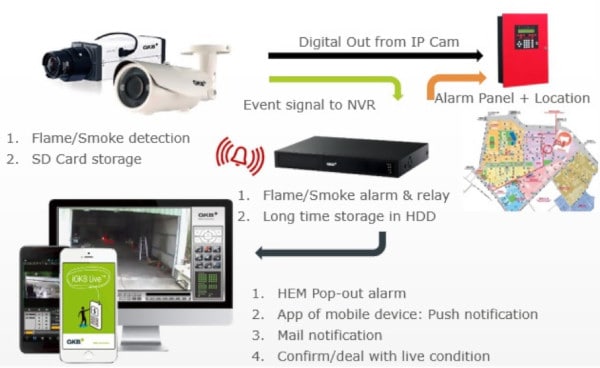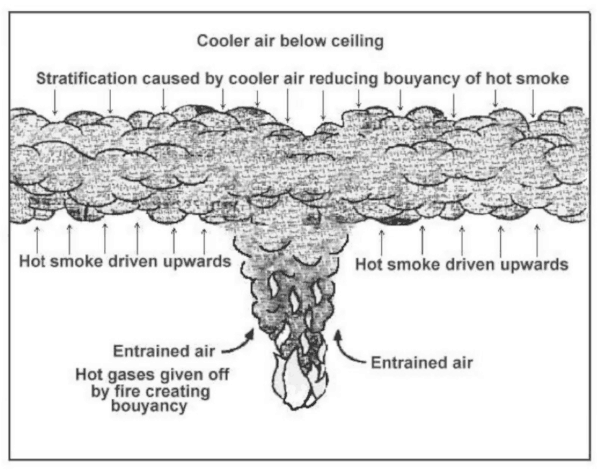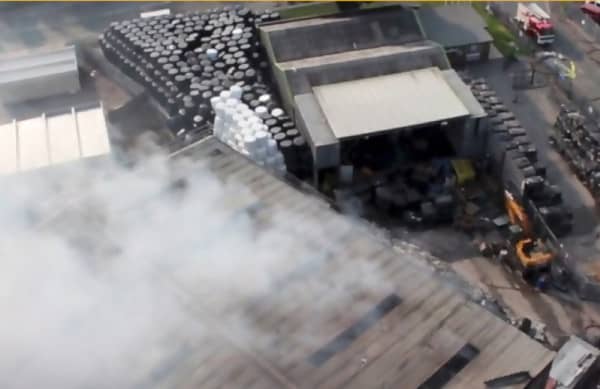New fire safety technology uses cameras and computer algorithms to detect smoke and fire
Smoke detectors save lives and property, providing early warning that enables occupants to quickly evacuate and often triggering other fire protection systems. And rapidly advancing technology—including video smoke detection—is offering new ways to spot smoke and fire that offer certain advantages over traditional detectors.
At home, simple ceiling-mounted detectors (aka smoke alarms) that use infrared beams or ionization chambers to detect smoke molecules are common. Commercial and industrial smoke and flame detectors are often more specialized and may include addressable models which quickly identify the exact location of the alarm, as well as various technology such as laser detectors that are much more sensitive to smoke. Detectors may be set up to activate certain sprinkler systems, automatically summon the fire department, and even modulate HVAC systems. One of the most interesting and promising new technologies in this area is video image detection (VID) of smoke and flame.
QRFS carries tried and true fire protection technology. Be sure to check out our selection of commercial and residential sprinkler heads, installation tools, fire extinguishers, heavy-duty head guards that protect sprinklers from accidental damage or vandalism, and much more.
Video image smoke and flame detection: how it works
Technology and Equipment
VID is divided into two categories: smoke detection and flame detection. Video image smoke detection is abbreviated most commonly as VISD but is also called VSD. Video image flame/fire detection is likewise abbreviated as VIFD or VFD.
All VID systems rely on two components to detect smoke and fire—cameras and computer algorithms. Cameras monitor an area, usually a large open space like a warehouse floor, and share the footage with a computer. In some systems, each camera houses a dedicated computer, whereas others have cameras transmit footage to a centralized computer.
Using normal security cameras connected to a central computer with VID software can save money. On the other hand, cameras with onboard software can be more easily configurable and might be specifically designed to directly interface with alarm control panels.
In either case, the computer runs an algorithm “trained” to identify groups of pixels exhibiting signature behaviors of smoke and/or fire. When smoke or flame is detected, the computer sends a signal to an alarm control system.
This video shows a video smoke detection system in action, including how it spots smoke by identifying groups of pixels that exhibit certain signature characteristics:
Most camera-based detection systems rely on visual-spectrum imagery (in color or black-and-white) to detect smoke and fire. Some more-advanced systems are infrared-sensitive and are paired with IR illuminators to function in the dark. Others use thermal imagery. Thermal systems, however, might be impractical for many industrial environments with many heat-generating engines or warm bodies.
While VISD and VIFD can vary in the sensing technology they use, the main difference between them is the cues used by the software to detect trouble. But VID systems can and often do check for both smoke and flame.
VID and fire code
VISD and VIFD technologies are both recognized by National Fire Protection Association model codes (specifically, NFPA 72: National Fire Alarm and Signaling Code) alongside other detector types like ionization, photoelectric, and thermal detectors. Sections 17.7.7 and 17.8.5 of the 2019 edition of NFPA 72 generally specify that VID systems should:
- Be made of components (hardware and software) listed for smoke or flame detection.
- Ensure proper facilities coverage based on an engineering survey and in accordance with published manufacturer guidelines.
- Be secured against tampering and give a trouble signal when unable to function properly.
You should read the NFPA model codes thoroughly, check your local fire code, and consult with safety and code professionals before implementing a VID system.

Applications—how to know if video smoke detection is right for you
Unless and until the technology becomes cheaper and more widespread, VID will probably not be the first choice for most homes and businesses. For residential and small commercial settings, small ceiling-mounted detectors are likely more than adequate. They can be placed wherever they are needed and fit easily into custom alarm systems.
Even in larger commercial or industrial settings, conventional detector systems often provide sufficient coverage. Facility owners or managers may consider installing a VID system if they need to monitor an area that meets any of the following conditions:
- The area is very large and open with a very high ceiling.
- The area is outdoors.
- The area requires a particularly quick fire response because it houses high-value assets, volatile or explosive substances, or substances and equipment under high pressure.
- The area will always be under comprehensive video surveillance.
Of course, consult with a professional to determine the best course of action.
High ceilings and large open spaces
Video smoke detection may be a great solution for large open areas with no ceiling or a high ceiling. Warehouses and factory floors, for example, pose certain smoke detection challenges. Even with the advantages provided by optical beam or aspirating detectors, achieving full coverage in very large facilities can be difficult.
In addition, many conventional detectors require contact with smoke or heat to detect fire. The higher the ceiling, the longer it takes smoke or heat to travel from a fire on the floor to the ceiling detector.
Moreover, smoke and heat might not actually reach high-mounted detectors because of a phenomenon called thermal stratification. Smoke cools as it rises, reducing its buoyancy relative to the surrounding air. Thus, smoke may cool and stop rising before it even reaches detectors in certain environments. Drop pipes connected to aspirating smoke detector systems, for example, can account for this by drawing smoke towards detectors faster.

VID systems work in spite of thermal stratification because they bypass the need for physical contact and reduce the number of sensors needed. Video smoke detection naturally provides floor-to-ceiling coverage everywhere in their field of view. Smoke does not have to rise to any detector to be spotted.
Detecting smoke and fire in outdoor spaces
VISD could be an ideal choice for fire detection in outdoor settings like forests, oil rigs, quarries, and construction sites. Fire detection is difficult in these places because they have all the challenges of large indoor spaces with the added complication of no structures to compartmentalize the smoke. Conventional smoke detection in outdoor settings may be ineffective because there is either no place to mount detectors or no practical way to achieve meaningful coverage.
With wildland fires becoming more common and destructive, VISD seems a likely tool for providing early fire warning in areas that are difficult to monitor. Researchers worldwide are making promising tests of VISD algorithms used for this purpose. For those interested, the papers “Forest Fire Smoke Detection in Video” and Early Smoke Detection of Forest Wildfire Video,” as well as a 2014 report from Fujitsu Global give more detailed information about the mechanisms and success of algorithms for monitoring forests.

Quick investigation, critical detection in hazardous environments
Seconds matter when it comes to smoke and fire detection in places with volatile or explosive materials. Because VID systems do not require contact with smoke, they can raise an alarm as soon as smoke or flame signatures enter their field of vision. According to a study by Schirmer Engineering commissioned by axonX to test Fike’s VID technology, VID systems detect smoke and fire at speeds comparable to or faster than conventional detection systems. This makes them a good choice in settings like laboratories, chemical plants, refineries, and boiler rooms.
Video smoke detection also allows humans to quickly asses risk in the event of an alarm. Using a video feed, security personnel can determine within seconds where an alarm originates and whether to cancel the alarm or take further action.
Challenges to video smoke detection
Maintaining line-of-sight
VID systems have to maintain line-of-sight on a fire and/or a plume of smoke to function. If VID is used as the primary means of smoke and fire detection, the cameras must always have enough light to function, they must achieve sufficient visual coverage of the facilities, and the movement of vehicles or supplies must not obstruct their view. VID users will also have to consider the impact power outages could have on their fire alarm systems and plan redundancies.
Set-up, calibration, and false alarms
VID systems are not ready to use out of the box. Like many smoke and flame detection systems, they need to be installed by a professional. Every location is unique, so VID software needs to be adjusted to properly detect threats in its working environment. If a system is not calibrated correctly, it might fail to detect actual hazards or give false alarms. Even if the manufacturer is consulted and a VID system is set up properly, there might be a period of trial and error during which the system gives false alarms as it “learns” to distinguish between relevant and irrelevant cues (for instance, between smoke or fire and an insect swarm or a welding flame).
Cost, equipment, set-up, and maintenance
Video image smoke and flame detection come with unique needs and expenses. Unlike some detection systems, VID depends on software which must be programmed (including to eliminate false alarms) and maintained. Specialized cameras and enough cameras to sufficiently cover a large area add to the expense, along with the cost of professional installation.

The future of video smoke detection and VIFD
Look for VID systems to become cheaper and more powerful as computing technology and adoption advance. Early and current algorithms follow “rules” related to shapes, colors, and motion in images. However, machine learning and artificial intelligence show extreme promise in VISD, VIFD, and other fire detection technologies. Future algorithms will make faster and more accurate decisions based on rapidly learning as they analyze.
The VID market is a relatively small one. Only a few systems are available in the U.S. at present, though there are large suppliers serving Europe. That said, expect more VISD and VIFD systems to be available stateside as the tech develops.
Smoke and flame detectors have long provided valuable warning in the event of a fire, saving lives and property. And developing VID systems offer the advantage of detecting smoke and flame without physically touching a warning cue. Though they’re not perfect for all situations, the remote-sensing capabilities of this technology make it a good choice for monitoring large open areas, outdoor spaces, or certain sensitive facilities and equipment. And as the hardware and software improve, VID may become cheaper, easier to set up, faster, and more reliable.
Whatever your fire protection system, make sure you have the equipment necessary to respond. At QRFS, we keep a close eye on new technological developments and sell tried-and-true fire protection equipment. Check out our selection of fire extinguishers, fire hoses and nozzles, fire hydrants, fire sprinklers, and much more.
If you have questions or need help finding an item, give us a call at +1 (888) 361-6662 or email us at support@qrfs.com.
This blog was originally posted at blog.qrfs.com. Check us out at Facebook.com/QuickResponseFireSupply or on Twitter @QuickResponseFS.



hi we had tender for forest fire and smoke detection for cctv
kindly please provide us information on your product
regards
karen
Karen — We do not sell this equipment; we write about everything in fire protection, however!
Question…do lights have to be on at all times in order for the cameras to detect smoke?
Linda — your question is best answered by the manufacturer of a given system/camera. But taking Bosch’s Aviotec Starlight 8000 as an example, it claims “excellent performance under low-light conditions” though it also “needs a minimum illumination of 2 lx” (which is a little brighter than “deep twilight“), has a day/night mode, and cautions to avoid backlighting areas where there may be smoke. But again, you should review a manufacturer’s manual to determine a given system’s capabilities. Thanks for the comment!